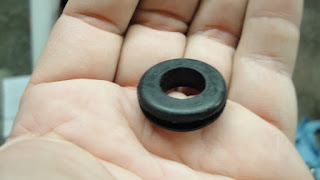So after a bit of deliberating, I decided to purchase a 2012 KTM 300XC from my good friends down at Fun Mart Cycle Center. I try to ride year round, so this is going to be my "do all" bike. My summer riding consists of racing Enduro's, and hare scrambles, as well as riding as many dual sports and local trails as practicable. I am fortunate enough to ride a lot with my good Teammates on Team P&G Offroad Racing as well as the Madison Motorcycle Club. I know that I often search the web for "bike setup" tips and opinions, to aide in my bike setup, so I thought I would document my setup to hopefully help someone in their setup. Take this guide for FWIW, but this is my setup.
So what do you do when you get a brand spanking new bike? Take it apart, of course!
So what do you do when you get a brand spanking new bike? Take it apart, of course!
Speedy Tip!
Custom Rear Axle Holder
Place your rear axle in your silencer when removing rear wheel.















































